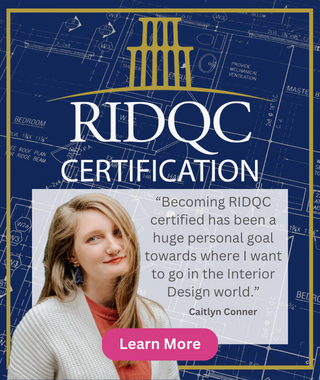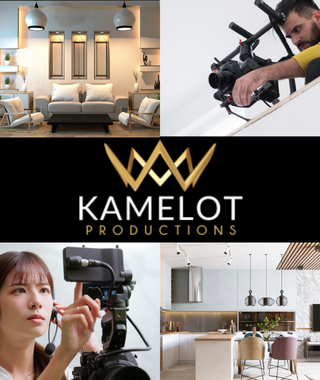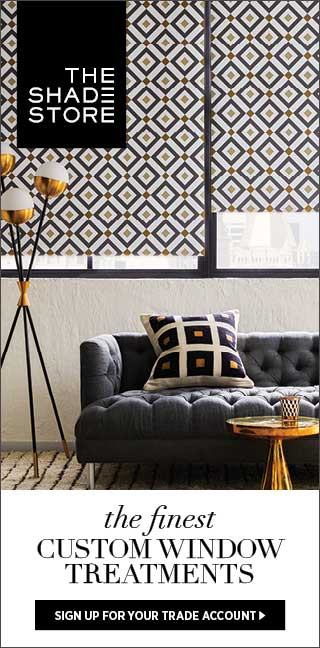DSA Newsletter - July / August 2010
Notes from Natasha
 As we all work to recover from extended downtime in a struggling economy, financial experts suggest you use spare time increasing your credentials and sharpening your skills. Take advantage of this opportunity to stand out amongst your competition.
As we all work to recover from extended downtime in a struggling economy, financial experts suggest you use spare time increasing your credentials and sharpening your skills. Take advantage of this opportunity to stand out amongst your competition.
DSA can help you move to the front of the pack by arming you with the knowledge we teach in our Residential Interior Designer Exam (R.I.D.E.). This qualifying examination is available to residential interior designers looking to advance their education, career and professional status in the interior design industry. Click here for more info about the R.I.D.E Certification Program.
If you are driven to succeed and dedicated to your profession, successful completion of the R.I.D.E. will enhance your status among residential interior design peers who have also reached this higher level of certification achievement. The R.I.D.E. testing program is recognized as an industry standard for excellence and certification can be the professional boost you need to grow your business and your reputation.
 The R.I.D.E. is a two-part examination that fully conforms to established testing standards and is administered by testing centers across the country. For your convenience, the exam is available both on scheduled dates and on an as-needed basis.
The R.I.D.E. is a two-part examination that fully conforms to established testing standards and is administered by testing centers across the country. For your convenience, the exam is available both on scheduled dates and on an as-needed basis.
Next, I would be remiss this month without mentioning how proud I am of our troops - and their families - who sacrifice so much for our freedom. In honor of these brave men and women, anyone signing up or renewing in July will receive two years for the price of one. DSA is pleased to extend this offer to our fellow proud Americans in celebration of Independence Day.
Celebrate your freedom!
Natasha Lima Younts
Founder
Designer Society of America
Establishing the Freedom Movement
Patti Morrow
 Not a week goes by that I don't receive multiple inquiries as to why I became involved in fighting the interior design cartel and how the interior design Freedom Movement started. I'm not an attorney, not a lobbyist, never wanted to be a political activist. I'm just an interior designer who couldn't bear to see the entire interior design industry destroyed. Yes, interior design is more than decoration, but it's also more than just being able to read codes. All designers want their clients to be safe in their spaces, but our opponents' drive to deny the aesthetic aspects of the profession smacks of lack of confidence in their ability, vision, and creativity.
Not a week goes by that I don't receive multiple inquiries as to why I became involved in fighting the interior design cartel and how the interior design Freedom Movement started. I'm not an attorney, not a lobbyist, never wanted to be a political activist. I'm just an interior designer who couldn't bear to see the entire interior design industry destroyed. Yes, interior design is more than decoration, but it's also more than just being able to read codes. All designers want their clients to be safe in their spaces, but our opponents' drive to deny the aesthetic aspects of the profession smacks of lack of confidence in their ability, vision, and creativity.
I now find myself in a totally unforeseen career — educating, organizing and mobilizing grassroots and traveling the country with pink slingshot and pink boxing gloves in tow.
Last month, after sharing my story with a fellow designer, she said, “That's so inspiring. You should write a book.” So after giving it some thought, I decided to craft not a book but instead a short autobiographical documentary which details my motivation, experience, and the pathway to protecting the design community's rights to earn a living.
It's been one wild rollercoaster ride, but second only to motherhood, no other endeavor has ever been so gratifying. I know, we're not curing cancer or solving world peace, but saving thousands of jobs, well, that's a good thing.
The Beginnings of the Movement
 Like many other interior designers, I entered the field as a second career [to be precise third, the first in business and second as a watercolor artist/teacher]. I started out “decorating” for friends and family, which in time led to more technical “design,” including new construction projects. Experience taught me a lot; I improved as time went on, my clients were delighted with the results in their homes and commercial spaces, and I never once jeopardized anyone's safety. I decided to pursue a 2-year interior design program — while still practicing — to continue to learn more, particularly in some of the more technical areas. All the students at the New Hampshire Institute of Art (where I am now adjunct faculty) were like me — entering the field as a second career. When the Interior Design Department Head, Phoebe Ann Neiswenter, first introduced the concept of interior design licensing, I was appalled (as was she) at the idea for philosophical (unnecessary, one-size-fits-all restrictions) and personal (prohibit me from practicing) reasons, but since my state was not regulated, I took notice but not action.
Like many other interior designers, I entered the field as a second career [to be precise third, the first in business and second as a watercolor artist/teacher]. I started out “decorating” for friends and family, which in time led to more technical “design,” including new construction projects. Experience taught me a lot; I improved as time went on, my clients were delighted with the results in their homes and commercial spaces, and I never once jeopardized anyone's safety. I decided to pursue a 2-year interior design program — while still practicing — to continue to learn more, particularly in some of the more technical areas. All the students at the New Hampshire Institute of Art (where I am now adjunct faculty) were like me — entering the field as a second career. When the Interior Design Department Head, Phoebe Ann Neiswenter, first introduced the concept of interior design licensing, I was appalled (as was she) at the idea for philosophical (unnecessary, one-size-fits-all restrictions) and personal (prohibit me from practicing) reasons, but since my state was not regulated, I took notice but not action.Member Spotlight
Instead of our regular feature, spotlighting one of our own, this month's Member Spotlight sends kudos to all of our enlisted men and women, both stateside and abroad. If you are able, consider participating in programs organized by AnySoldier.com. Here is their story:
It was March 26th, 2003. Army Sergeant Brian Horn, one of 1,000 soldiers, parachuted into enemy territory in Northern Iraq. Five months later, Brian Horn was able to call his parents. Marty and Sue Horn had been sending their son an average of six care packages per week. So when Brian asked his parents to send more, they thought he was kidding. But Brian wanted them for soldiers that weren't receiving anything.
 Both Marty and Sue Horn had spent their careers in the military, so they immediately understood what Brian was saying. Millions of these men and women serving overseas never receive any mail. Besides often lacking basic necessities, these men and women have to cope with the harsh conditions of serving overseas without signs of support from friends and family back home.
Both Marty and Sue Horn had spent their careers in the military, so they immediately understood what Brian was saying. Millions of these men and women serving overseas never receive any mail. Besides often lacking basic necessities, these men and women have to cope with the harsh conditions of serving overseas without signs of support from friends and family back home.
The Horns developed the idea for AnySoldier.com during that phone call. Marty created a website that explained the project and offered Brian's address -- including the words "Attn: Any Soldier". Brian would give these packages to the soldiers not receiving any mail. "Within two weeks, we were getting flooded with email from all over the world,” said Marty. “It was like an avalanche."
The growth has continued. To date, the program has served over 1.4 million troops stationed in 22 locations. Visitors to AnySoldier.com can search for contacts by service location, where the unit comes from, the number of males or females in the group (some supporters prefer to write to "Attn: Any Female Soldier"), and the number of times their address has been requested -- among other options.
Visit AnySoldier.com to see how you can participate. Show your appreciation today!Tips from Studio WebWare
Last month we shared with you some information about Studio WebWare and all the benefits their Studio Designer software program offers to interior designers. This month we'll address the ease with which designers can use the program on the go via Blackberry, iPhone and Droid.
Studio WebWare has a number of applications to make your life simpler. One of the most popular features offered is an interface from manufacturers' websites to Studio Design.
Designers using Studio WebWare can browse websites of manufacturers offering fabrics, furniture, or other products and select the items they want to transfer information for to Studio WebWare, said Lance Haeberle.
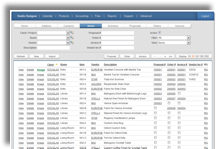 Here's how it works: an interior designer browsing on a manufacturer's website selects an item and can automatically transfer the information to Studio Designer. They can then integrate that information, including a product description, pricing and an image of the item to use on proposals, orders, invoices and requests for quotes.
Here's how it works: an interior designer browsing on a manufacturer's website selects an item and can automatically transfer the information to Studio Designer. They can then integrate that information, including a product description, pricing and an image of the item to use on proposals, orders, invoices and requests for quotes.
“Bottom line is this saves time and can automatically generate reports they need without cut, copy and paste,” said Haeberle.
Studio WebWare is just starting to roll out the interface and currently has five manufacturers linked directly, said Haeberle. One of the sites linked is decorate.com, which in itself provides access to 500 online manufacturers. Any new manufacturer can request to be linked to Studio Designer free of charge.
You can link product information directly to Studio Designer from these sites:
www.Decorati.com
www.MichaelSmithInc.com
www.JedJohnson.com
www.QuintusHome.com
Tune in next month for more helpful hints regarding Studio WebWare and Studio Designer. Visit them online at studiowebware.comComfort or Quantity
 By Mary Dennis
By Mary Dennis
www.gracefullifestyles.com
I was recently asked to Feng Shui design a sales center in Las Vegas. It is a prominent location where over 100 clients pass thru daily, seven days a week. The reception area housed 40 seats all lined up against the walls. One specific detail I was to change was the chairs. The requirement was to purchase smaller ones, so as to get more seating into the space.
Ah, the challenge rose deep within me and I could not help but think of the first rule of thumb for any Graceful Lifestyles Designer - No harm to the public!
I had recently read a report from the Center for Disease Control stating that one-third of the American public was overweight. Obese adults sit sideways, producing feelings of being uncomfortable, wanting to get out of a space or being constricted in a tight spot.
Are these the kind of feelings that would encourage comfort, I asked myself?
My Umbrella Design Value for this location is trust and building relationships. My intention for the design was a notice of “We care about your comfort,” and our product will bring comfort and enjoyment to your life. Ok, so how do I provide comfort for 30 percent of the clients that are walking in the door and space is limited? How do I support my client's intentions of increasing sales through the design of the space and correct placement?
The pictures below show how all size people can find comfortable seating with bariatric chairs. The Arissa Collection, from KI Designs, works for all users of all shapes and sizes.
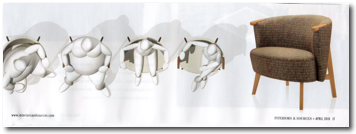
Multipurpose seating for all size people? Bingo! And it has some style as well!
SKI Designs took a standard size chair, made it wider and reinforced it structurally, resulting in a 36-inch wide chair that will hold up to 750 pounds. Adding the bariatric seating was a primary component to designing a space that said, “Trust me - we care about YOU!” In addition, built-in upholstered seating was also added, satisfying my client's need for more seating as well as the occupants' comfort.
One may ask, so what's so Feng Shui about this solution? Comfort, care and well being are all a part of understanding the importance of the person place connection and correct placement.
Comfort and Quantity satisfied.
Member Services
 Note: We apologize! Karen Gleason's column was inadvertently left out of June's newsletter. Sorry!
Note: We apologize! Karen Gleason's column was inadvertently left out of June's newsletter. Sorry!
Natasha and I had a really good time in Atlanta at Visions 10. The R.I.D.E. certification is such a good program that it was not hard to convey all the good information to new students and designers. I enjoyed meeting everyone and making new contacts.
 Summer is here and to some that means time to kick back and relax, but not for DSA! We are ramping up our launch to chapter groups, R.I.D.E. is having a successful kick-off and we are in the process of making more benefits available to our members.
Summer is here and to some that means time to kick back and relax, but not for DSA! We are ramping up our launch to chapter groups, R.I.D.E. is having a successful kick-off and we are in the process of making more benefits available to our members.
If you are interested in being a Chapter leader, please contact me at karen.gleason@dsasociety.org. We still have an available region and need someone who is excited about DSA to lead the charge.
We are now taking payments for membership and/or certification for new members and renewals. Please contact Cindy at 229.888.2459 or Karen at karen.gleason@dsasociety.org for more information.
July marks our big chapter kickoff. We will be getting out the contact information for your leader and launching a part of DSA that we are excited about for the future.
I am so excited about what is happening at DSA in general. The excitement is catching, and we all have to keep working hard at spreading the news that certification and equal membership is available to all designers with education/experience, not just a handful that happened to go to the right schools.
The best part of the Vision10 expo was hearing all the stories, good and bad, so that we can strive to stand behind our motto, “A Society Designed with You in Mind.” I think we are doing a good job at it!
Make YOUR life easier! - Tips from Studio WebWare
 Last month we shared with you some information about Studio WebWare and all the benefits their Studio Designer software program offers to interior designers. This month we'll address the ease with which designers can use the program on the go via Blackberry, iPhone and Droid.
Last month we shared with you some information about Studio WebWare and all the benefits their Studio Designer software program offers to interior designers. This month we'll address the ease with which designers can use the program on the go via Blackberry, iPhone and Droid.
While designers can access their entire Studio Designer application from any computer, they can also log in via cell phone to the mobile portion of the application, said Lance Haeberle of Studio WebWare.
The mobile app provides two primary features: One allows users to access their address books where they can view and edit and have an unlimited number of entries. From there they can also link to websites or view of map with directions to a particular client or vendor, he said.
 Secondly, users can also maintain their activities such as scheduling meetings, tracking conversations and entering and receiving reminders. Users can also access their "to do" list for the day and enter start and end times for meetings and appointments.
Secondly, users can also maintain their activities such as scheduling meetings, tracking conversations and entering and receiving reminders. Users can also access their "to do" list for the day and enter start and end times for meetings and appointments.
"That info is tracked in real time in the main application so they can generate their time billing invoices at the end of the month," offered Haeberle, noting that accessing Studio Designer via phone does not require synching the activity with a computer later.
"If they make changes on their phone it automatically updates on the main system," he said.
Tune in next month for more helpful hints regarding Studio WebWare and Studio Designer. Visit them online at www.studiowebware.comBusy in 2009? Or Not?
Gail Goby ASID, DSA
 Starting in 2007, the market for interior designers turned into quicksand. The credit markets tightened, and projects that typically went to designers were brought in-house both residentially and commercially.
Starting in 2007, the market for interior designers turned into quicksand. The credit markets tightened, and projects that typically went to designers were brought in-house both residentially and commercially.
HGTV and the Internet created more competitors in the middle of the market from the consumers themselves, and frankly, for most designers, those weren't and aren't your best clients anyway.
High-end projects stayed fairly steady until the economic debacle of October 2008, and then many of the projects slowed, stopped or didn't start at all. Especially in markets tied to the financial markets like New York, the wealthiest clients lost their jobs and their sense of security if they were in jobs associated with money and wealth. The commercial market was devastated by the credit crisis, and according to economists, the concerns aren't behind us yet.
Even with this perfect storm, some designers were very busy. Why? They adapted to the market shifts, changed their pricing strategies, developed an online presence, spent as much as 10 percent on marketing, focused on a niche, learned how to differentiate themselves better, and didn't wait for the phone to ring. They took these conditions as a challenge and they worked even harder than before.
If commercial and hospitality is your preferred area of business, you'll want to focus on renovations. If you can show companies that an investment in renovation can lead to more dollars at the bottom line especially if they depend on consumer spending, then you have an opportunity to build a logical reason why a company should invest. The commercial designers that become a marketing partner with their clients differentiate themselves and become a valuable solution-oriented team member instead of an expense.
 If your specialty is residential design, bathroom and kitchen renovation is still steady. The budgets might be smaller, but there is work in this specialty area.
If your specialty is residential design, bathroom and kitchen renovation is still steady. The budgets might be smaller, but there is work in this specialty area.
Some designers created packages of services they offered on their websites. Why did that work for them? The consumers wanted (and demanded) to know the investment required.
Other designers offered Value Based Fees because consumers resisted hourly fees. ASID surveyed consumers a few years ago and approximately 70 percent said they wanted fixed fees. Designers who offered this option found that it completely shifted their role from an hourly wage slave to a trusted advisor, and that helped many designers kick-start their businesses even during the last several months.
You could be the greatest designer, but if people don't hear about you consistently, then your business will struggle. These days, you need great photography, a great head shot, articles about you in magazines, online and in newspapers (third party endorsements), a web presence including a website, blog and social media and search engine optimization of your website and blog.
And, if you don't have a written business plan, marketing plan, vision and strategy for your business, it's time to get busy and take action. Referrals and networking may have worked in the past, but they are less effective than ever, so that means it's time to rethink and reposition your business.
 Gail Doby, ASID,DSA, is co-founder and Chief Vision Officer of Design Success University. Gail is an Interior Design Business Success Mentor to thousands of interior designers globally. DSU's mantra is to “define your success strategy and make your competition irrelevant.” DSU's Business Mastery Membership and classes include Value Based Fee System, Marketing Intensive I — Winning With New Strategies for Traditional Marketing, Social Media Intensive How to Engage Your Prospects Online, and Positioning for Profit & Market Domination. Contact DSU for a Virtual Marketing Platform consultation for your business. Request your complimentary copy of DSU's Interior Design Fee & Salary Survey eBook and IDEAS newsletter subscription filled with inspiration, business tips and time-saving resources.
Gail Doby, ASID,DSA, is co-founder and Chief Vision Officer of Design Success University. Gail is an Interior Design Business Success Mentor to thousands of interior designers globally. DSU's mantra is to “define your success strategy and make your competition irrelevant.” DSU's Business Mastery Membership and classes include Value Based Fee System, Marketing Intensive I — Winning With New Strategies for Traditional Marketing, Social Media Intensive How to Engage Your Prospects Online, and Positioning for Profit & Market Domination. Contact DSU for a Virtual Marketing Platform consultation for your business. Request your complimentary copy of DSU's Interior Design Fee & Salary Survey eBook and IDEAS newsletter subscription filled with inspiration, business tips and time-saving resources.Learn about Green Building on Webinars
If you are new to “green building” and want to learn a little on the cheap, there are many options. United States Green Building Council (USGBC) offers a variety of webinars that you can view from your home or office. Some are live and must be watched on a specific time and date, but many are available on demand. While prices can range up to $100, many are free as the USGBC wants people to learn about their mission. You do not have to be a USGBC member to participate in the webinars.
Here are a few that are currently being offered:
- Daylighting: Connecting to the Outdoors
- Solid State Lighting
- Low-Emitting Materials
- Water Efficient Plumbing
- Windows for Sustainable Design
- Indoor Environmental Quality
- Regional & Renewable Materials in LEED
- Lighting Basics for Energy Efficient Applications
There are also webinars aimed at the various Leadership in Energy and Environmental Design (LEED) rating systems. These include homes, retail and the upcoming healthcare rating system.
If you are interested in areas outside of interior design, you are in luck. Here are a few:
- Sustainable Interior Design for the Facilities Manager
- Behind the Credit: Forest Stewardship & Third Party Certification
- How Manufacturers and Designers Communicate about Green Products
- HVAC Contractor Responsibilities
- Energy Systems Introduction
You can learn about these webinars and others by visiting www.usgbc.org. Look under Education, and then Course Offerings.
 Go Green,
Go Green,
Craig Ressler, P.E.
Sustainability Researcher
Easy To Be Green
www.easytobegreen.com
 As we all work to recover from extended downtime in a struggling economy, financial experts suggest you use spare time increasing your credentials and sharpening your skills. Take advantage of this opportunity to stand out amongst your competition.
As we all work to recover from extended downtime in a struggling economy, financial experts suggest you use spare time increasing your credentials and sharpening your skills. Take advantage of this opportunity to stand out amongst your competition. The R.I.D.E. is a two-part examination that fully conforms to established testing standards and is administered by testing centers across the country. For your convenience, the exam is available both on scheduled dates and on an as-needed basis.
The R.I.D.E. is a two-part examination that fully conforms to established testing standards and is administered by testing centers across the country. For your convenience, the exam is available both on scheduled dates and on an as-needed basis.
 Not a week goes by that I don't receive multiple inquiries as to why I became involved in fighting the interior design cartel and how the interior design Freedom Movement started. I'm not an attorney, not a lobbyist, never wanted to be a political activist. I'm just an interior designer who couldn't bear to see the entire interior design industry destroyed. Yes, interior design is more than decoration, but it's also more than just being able to read codes. All designers want their clients to be safe in their spaces, but our opponents' drive to deny the aesthetic aspects of the profession smacks of lack of confidence in their ability, vision, and creativity.
Not a week goes by that I don't receive multiple inquiries as to why I became involved in fighting the interior design cartel and how the interior design Freedom Movement started. I'm not an attorney, not a lobbyist, never wanted to be a political activist. I'm just an interior designer who couldn't bear to see the entire interior design industry destroyed. Yes, interior design is more than decoration, but it's also more than just being able to read codes. All designers want their clients to be safe in their spaces, but our opponents' drive to deny the aesthetic aspects of the profession smacks of lack of confidence in their ability, vision, and creativity. Like many other interior designers, I entered the field as a second career [to be precise third, the first in business and second as a watercolor artist/teacher]. I started out “decorating” for friends and family, which in time led to more technical “design,” including new construction projects. Experience taught me a lot; I improved as time went on, my clients were delighted with the results in their homes and commercial spaces, and I never once jeopardized anyone's safety. I decided to pursue a 2-year interior design program — while still practicing — to continue to learn more, particularly in some of the more technical areas. All the students at the New Hampshire Institute of Art (where I am now adjunct faculty) were like me — entering the field as a second career. When the Interior Design Department Head, Phoebe Ann Neiswenter, first introduced the concept of interior design licensing, I was appalled (as was she) at the idea for philosophical (unnecessary, one-size-fits-all restrictions) and personal (prohibit me from practicing) reasons, but since my state was not regulated, I took notice but not action.
Like many other interior designers, I entered the field as a second career [to be precise third, the first in business and second as a watercolor artist/teacher]. I started out “decorating” for friends and family, which in time led to more technical “design,” including new construction projects. Experience taught me a lot; I improved as time went on, my clients were delighted with the results in their homes and commercial spaces, and I never once jeopardized anyone's safety. I decided to pursue a 2-year interior design program — while still practicing — to continue to learn more, particularly in some of the more technical areas. All the students at the New Hampshire Institute of Art (where I am now adjunct faculty) were like me — entering the field as a second career. When the Interior Design Department Head, Phoebe Ann Neiswenter, first introduced the concept of interior design licensing, I was appalled (as was she) at the idea for philosophical (unnecessary, one-size-fits-all restrictions) and personal (prohibit me from practicing) reasons, but since my state was not regulated, I took notice but not action. Both Marty and Sue Horn had spent their careers in the military, so they immediately understood what Brian was saying. Millions of these men and women serving overseas never receive any mail. Besides often lacking basic necessities, these men and women have to cope with the harsh conditions of serving overseas without signs of support from friends and family back home.
Both Marty and Sue Horn had spent their careers in the military, so they immediately understood what Brian was saying. Millions of these men and women serving overseas never receive any mail. Besides often lacking basic necessities, these men and women have to cope with the harsh conditions of serving overseas without signs of support from friends and family back home. Here's how it works: an interior designer browsing on a manufacturer's website selects an item and can automatically transfer the information to Studio Designer. They can then integrate that information, including a product description, pricing and an image of the item to use on proposals, orders, invoices and requests for quotes.
Here's how it works: an interior designer browsing on a manufacturer's website selects an item and can automatically transfer the information to Studio Designer. They can then integrate that information, including a product description, pricing and an image of the item to use on proposals, orders, invoices and requests for quotes.

 Note:
Note:  Summer is here and to some that means time to kick back and relax, but not for DSA! We are ramping up our launch to chapter groups, R.I.D.E. is having a successful kick-off and we are in the process of making more benefits available to our members.
Summer is here and to some that means time to kick back and relax, but not for DSA! We are ramping up our launch to chapter groups, R.I.D.E. is having a successful kick-off and we are in the process of making more benefits available to our members. Secondly, users can also maintain their activities such as scheduling meetings, tracking conversations and entering and receiving reminders. Users can also access their "to do" list for the day and enter start and end times for meetings and appointments.
Secondly, users can also maintain their activities such as scheduling meetings, tracking conversations and entering and receiving reminders. Users can also access their "to do" list for the day and enter start and end times for meetings and appointments. Starting in 2007, the market for interior designers turned into quicksand. The credit markets tightened, and projects that typically went to designers were brought in-house both residentially and commercially.
Starting in 2007, the market for interior designers turned into quicksand. The credit markets tightened, and projects that typically went to designers were brought in-house both residentially and commercially. If your specialty is residential design, bathroom and kitchen renovation is still steady. The budgets might be smaller, but there is work in this specialty area.
If your specialty is residential design, bathroom and kitchen renovation is still steady. The budgets might be smaller, but there is work in this specialty area. Gail Doby, ASID,DSA, is co-founder and Chief Vision Officer of
Gail Doby, ASID,DSA, is co-founder and Chief Vision Officer of 

